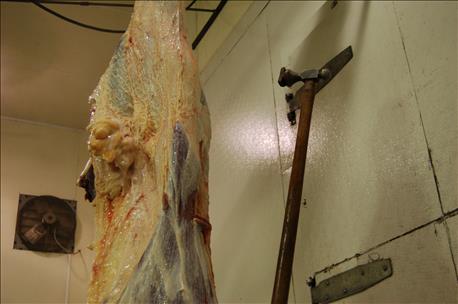
The Indiana legislature passed a food safety law this session. Katrina Hall, director of legislative services for Indiana Farm Bureau, Inc., calls it a good first start. The original intent was to address safety of small poultry butchering operations within Indiana.
Basically, the bill fills the gap for inspection and safety standards for operations killing more than 1,000 up to 20,000 chickens per year. These facilities must now receive a permit from the Indiana Board of Animal Health and gives BOAH the authority to inspect these establishments. Many of these are the ones that provide local meat for sale to restaurants, hotels and other public institutions.

READY TO INSPECT: Here is a beef carcass ready for the state inspector to check. If it passes, he will give it his stamp of approval. The legislature clarified some food safety laws this session, primarily related to poultry.
“It won’t affect someone selling meat at a farmers’ market,” Hall says. “It applies only to those places butchering more than 1,000 birds per year.”
While reading through this legislation, memories flooded back to me of a visit several years ago to a butchering facility. I wanted to see firsthand what happened when a state inspector was present to inspect meat and apply the state stamp. For the meat to be eligible for resale, animals have to be butchered and a carcass examined by a state inspector. The staff of inspectors is part of BOAH. I arranged with the person heading up the inspection division at the time, and we met at a processing plant. One of his veteran inspectors was there to do the actual inspection.
Cattle were being processed that day. I watched the animal killed, humanely, and then saw the carcass come around on the rail. The inspector showed me what he was looking for as the animal was dressed out and the carcass was prepared to go into the cooler to remain until it was ready to be processed.
Each half of the carcass was held onto the rail by shackles on the rear feet. Everything was going fine up until this point.
After the inspector had given the OK to a carcass, the plant manager told his employee to move it into storage. He opened the door to the cooler and slid the carcass along the rail.
All of a sudden, there was a big thud! Oops! The carcass derailed, and fell crashing to the concrete floor. As it turned out, the inexperienced employee forgot to check which way the rail inside the cooler was positioned. It was set to move carcasses a different direction. So when he slid the carcass , it basically ran off the end of the tracks, just like a train might derail.
I admit I felt sorry for the plant manager. Here was a state inspector, the head of inspecting for BOAH, and a journalist with a camera, all looking at this carcass, now on the floor. If I was the plant manager, it would have been my definition of a bad day! But he handled it very well.
What happened to the employee? We were told he would get a second chance. What happened to the carcass? I have no clue. When we left, it was laying on a cart pushed to the side of the rail.
It’s a visit and an interview I won’t forget!
About the Author(s)
You May Also Like




